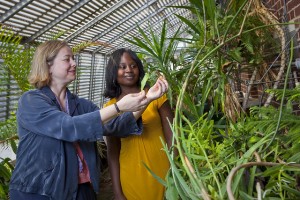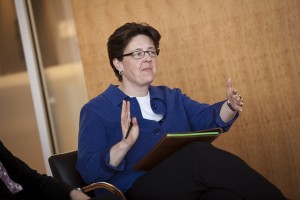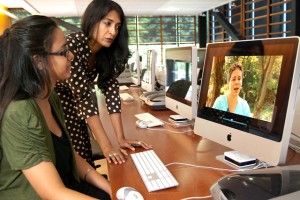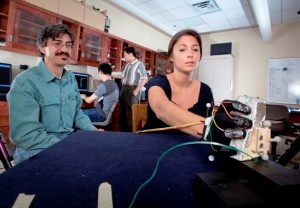
Anna Edlund, assistant professor of biology, works with Belinda Sibanda '11 in the Kunkel Hall greenhouse.
When President Daniel H. Weiss unveiled the College’s strategic plan in the fall of 2007, he said it was designed “to secure a place for Lafayette among the nation’s premier liberal-arts institutions.” Among its five key objectives are to increase the size of the permanent faculty by 20 percent and decrease the student-to-faculty ratio from 11:1 to 10:1. Nearly four years later, the College is more than halfway to reaching that goal.
According to Wendy Hill, provost and dean of the faculty, Lafayette has allocated or hired 15 new faculty positions and has commitments for four more, bringing the total to 19. The strategic plan calls for 35 new faculty positions. Even with the current economic uncertainty, the College is committed to increasing the value of its undergraduate education.
“Our faculty growth initiative is at the heart of our strategic plan,” explains Hill. “At a time when some institutions decided that it is best to just hunker down and defend the status quo, we took the view that this is precisely the time to push hard at accomplishing our strategic goals.”
Those who have already joined the faculty in new positions include Mary Armstrong, associate professor and chair of the women’s and gender studies program; Anna Edlund, assistant professor of biology; Peter Gildenhuys, assistant professor of philosophy; Luis Schettino, assistant professor of psychology; Nandini Sikand, assistant professor of film and media studies; and Yang Wang, assistant professor of economics.
Beginning in fall 2011, six faculty members are being hired for new positions, including Robert Blunt, assistant professor of religious studies; Benjamin Cohen, assistant professor of engineering studies; Michael Feola, assistant professor of government and law; Rachel Goshgarian, assistant professor of history; Justin Hines, assistant professor of chemistry; and Angelika Von Wahl, associate professor of international affairs.
Cohen and Von Wahl will be the first professors hired specifically for the College’s interdisciplinary programs in engineering studies and international affairs, respectively. New positions in environmental studies, mechanical engineering, and anthropology and sociology are next in line to be filled.
Lafayette faculty pride themselves in providing students with excellent learning opportunities in the classroom, field, laboratory, and beyond. All professors are also top scholars in their fields, and many work with students one-on-one or in small groups to conduct research. Lafayette has one of the highest percentages in the nation of students working with faculty on research.
One of the key facets in adding new faculty positions is to enhance interdisciplinary courses in all of the College’s academic divisions. These new faculty have expertise in areas that strengthen and expand course offerings.

Mary Armstrong, associate professor and chair of women’s and gender studies, leads a panel discussion during Women’s History Month.
In the fall of 2009, Armstrong became the first faculty member at Lafayette formally appointed in women’s and gender studies. She also holds the only joint faculty appointment in both women’s and gender studies and English. With 23 faculty members from 12 departments teaching core courses or electives in the program, it’s essential that they welcome the program’s interdisciplinary nature. This fall, Lafayette will offer an A.B. degree with a major in women’s and gender studies for the first time.
“It signals a real step forward for interdisciplinarity at the College and a turning point for a program that is really coming into its own,” Armstrong says. “I hope the major can build stronger relationships across disciplinary boundaries. We will definitely strengthen program offerings on gender in the global frame and in terms of science and engineering. I think bridges can be built between women’s and gender studies and any area of inquiry, and students really benefit from crossing those bridges.”
Armstrong developed two new interdisciplinary courses. Feminist Theory studies the intellectual traditions that structure ideas about gender and sexuality and examines how social, historical, and ideological forces shape different feminist traditions. Students in the Sexuality Studies course explore the cultural and social regimes that create and organize ideas about sexuality.
“These courses represent intersections between the kinds of topics and ideas students are used to exploring from a single intellectual vantage point,” she says. “Both courses require students to mentally switch gears and embrace multiple perspectives and to simultaneously employ different models for understanding complex social phenomena. I want to empower my students to think critically, listen well, express themselves clearly, and never stop wondering. And I really want them to have as much fun as I do along the way.”

Shehtaz Huq ’14, left, and Nandini Sikand, assistant professor of film and media studies, work together on a film project.
Like Armstrong, Sikand enjoys helping her students stretch their boundaries, even if it means delving into ideas that are uncomfortable. An award-winning independent filmmaker and television producer, Sikand joined the faculty last fall as the College’s first professor in the new film and media studies program. She teaches a course cross-listed with the women’s and gender studies program called Women Make Movies/Movies Make Women, in which students study women filmmakers and how women have been constructed on film.
Her latest film, Soma Girls, follows the lives of 30 girls ranging from 6 to 17 years old growing up in a hostel in Kolkata, India, who are attempting to overcome the circumstances they have been born into and lead ordinary lives. She’s collaborating with Mary Jo Lodge, assistant professor of English, and Andy Smith, associate professor of English and chair of film and media studies, on a film about David Heard, a 10-year-old Easton boy who passed away from a rare cancer called neuroblastoma, and The National Crane Project, in which he began an effort to install 1,000 origami cranes in every pediatric cancer center in the country. They will screen the film on campus Sept. 7.
Once the film is completed, David’s mother, Susan and Tom Heard ’91, will use it as a fundraising and awareness tool. Film’s transcendent power is something Sikand wants to share in her classroom. Not only does she want students to view films in ways they never have before, she wants to introduce them to filmmaking as a craft.
“I’d like to see a program that combines theory and practice, one that will attract a diverse group of students interested in film and media within the liberal arts context – in other words, students that have strong production skills, yet see the valuable social and cultural context of their work,” she says.

Luis Schettino, assistant professor of psychology, and Camille Borland '13 are researching a computerized, wearable glove that studies human grasping behavior.
For Schettino, his role in the classroom isn’t to hand out good and bad grades, but to facilitate the learning process. His area of expertise, neuroscience, is a naturally interdisciplinary field. This past spring, Schettino taught a capstone course called Neural Bases of Creativity. Students explored creativity from different evolutionary, ethological, computational, psychological, and literary/artistic points of view. Their goal was to identify how the brain or a computer produces novel, useful concepts.
Collaborating with colleagues and students outside the classroom also is important. His research focuses on the neuroscience of motor cognition – how the processes that organize human movement based on sensory information interact with the processes that use memory, emotion, and attention to understand the world and guide behavior.
Schettino worked with Yih-Choung Yu, professor of electrical and computer engineering, to design and implement a glove that reports the precise moment in which each of the fingers of a participant’s hand makes contact with a target object. An honors student used the system as part of her thesis last spring. This summer, he’s advising a student through the EXCEL Scholars program who is extending this work with plans to present their findings at the Society for Neuroscience meeting in Washington, D.C., this fall.
“My expertise is in the detailed analysis of human behavior. I do research that focuses on the millisecond by millisecond use of sensory information, including vision, hearing, touch, and proprioception to help the motor system predict the best behavioral responses,” explains Schettino. “My research program offers students an opportunity to observe and participate in experiments that are at the cutting edge of motor cognitive research, which gives them an awareness of the type of methodologies needed for present-day neuroscience.”




2 Comments
Comments are closed.